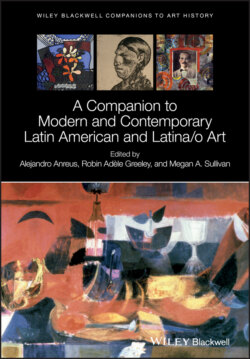Читать книгу A Companion to Modern and Contemporary Latin American and Latina/o Art - Группа авторов - Страница 23
1.2.2 José Clemente Orozco
ОглавлениеA fierce individualist, Orozco displayed a high degree of pessimism in regard to the Mexican government, whose office holders he saw as self‐serving and hypocritical. Orozco serves as the unrelenting critic of Mexican political and social developments at this time and his paintings as pointed barbs of outright sarcasm and poignant satire to remind his viewers of how much still needs to be done to right social wrongs. His targets are ignorance, greed, corruption, and violence, represented along the entire spectrum from far left to far right, especially clericalism.
This bitterness was forged in recollections of and meditations upon the bloodiest fighting of the revolution. In the Horrores de la Revolución (Horrors of the Revolution), produced in the mid‐1920s, Orozco made explicitly graphic black and white drawings of atrocities that had not lessened in his historical memory.2 During this time, he also illustrated for La Vanguardia, an anarcho‐syndicalist periodical.
In the mid to late 1930s, Orozco painted a group of large frescoes in the city of Guadalajara. By this time he had become completely disenchanted with what he saw as the corruption of the ideals of the Revolution of 1910. He also at this time began to participate in antifascist organizations, such as the Liga de Escritores y Artistas Revolucionarios (League of Revolutionary Writers and Artists, LEAR, founded in 1933), an allegiance quite atypical of him but telling of these years of response to the rise of international fascism.3
Of two important details in the Guadalajara murals, one is a monumental portrait of Father Miguel Hidalgo, leader of the independence movement of the early nineteenth century, when Mexico freed itself from the colonial control of Spain. This super‐scaled figure hovers dramatically over the main staircase of the Governor's Palace, wielding a flaming torch (illustrated in Rodríguez 1969, p. 325 and Rochfort 1993, p. 142). The importance of choosing Hidalgo as his hero is that Orozco in 1937 is turning away from contemporary figures. His own present could not be idealized. In this case, the flames are a symbol of mythical and cleansing power, purifying the violence of armed struggle.
The other major image from Guadalajara is El hombre en llamas (Man in Flames), painted inside the dome of the Cabañas Orphanage in 1938–1939 (illustrated in Rodríguez 1969, p. 333 and Rochfort 1993, p. 118). The central figure is one of four human forms who represent the four elements; earth, wind, and water being the other three. The flaming, nude male body floats in space directly above the viewer, pulling the eye and mind into a contemplation of philosophical and spiritual questions. There is nothing about the body that is either Mexican or of a specific time and place. The thematic context, being purely abstract, demonstrates how far Orozco has moved from the objective meanings of his earlier work. Here, the question of national identity, of the revolution, or of any relevance to the social realities of the period is replaced by cosmic transcendence. Flames generalize the form of the body and the torture by fire is displaced from the earth‐bound trauma of actual violence. The mystical nature of this image, however, confesses a profound political dissatisfaction on the part of the artist of any chance for Mexico to truly progress into advanced forms of social life. Orozco presents his paintings as the conscience of the revolution and finds it sorely wanting.
